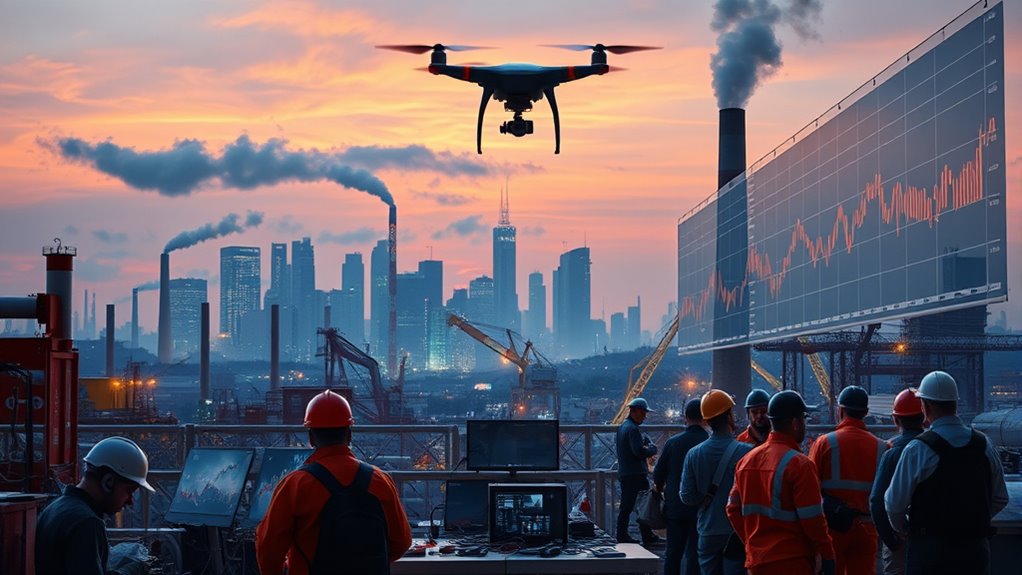As automation and AI reshape economies, traditional metrics like GDP no longer fully capture true progress or societal well-being. They overlook intangible gains, sector-specific benefits, and costs like inequality or environmental impact. Relying solely on GDP can miss these vital shifts. To better understand economic health today, you need to explore alternative measures and broader perspectives—stay with us to uncover how we might rethink measuring success in this digital age.
Key Takeaways
- GDP fails to capture intangible benefits like safety, quality, and societal well-being enhanced by automation and AI.
- Automation-driven job displacement and income inequality are not reflected in traditional GDP metrics.
- Sector-specific differences and rapid technological change challenge the consistency and relevance of GDP measurements.
- Automation increases economic efficiency, but its full impact on societal prosperity requires broader, more nuanced metrics.
- Developing alternative measures alongside GDP can better assess automation’s true economic and social contributions.
The Growing Role of AI in Economic Growth

Artificial intelligence is increasingly driving economic growth worldwide, transforming industries and boosting productivity. Over the next decade, AI could boost global GDP by up to 15 percentage points, contributing between $17.1 trillion and $25.6 trillion by 2030. North America and China are expected to benefit the most, considerably increasing their GDPs. AI could add about one percentage point to annual global growth, matching the impact of 19th-century industrialization. In sectors like banking, AI advancements, such as generative AI, could generate an additional $340 billion in value. As AI adoption grows—nearly doubling in organizations by 2024—the economic influence becomes more pronounced. However, the full benefits depend on responsible deployment and public trust to ensure widespread and equitable growth. Responsible deployment and societal trust will be crucial in realizing AI’s full potential to foster inclusive economic development. Additionally, understanding the role of automation in reshaping labor markets remains vital to managing transition challenges effectively, especially as technological change continues to accelerate across industries. Recognizing the impact of AI on productivity can help policymakers and businesses prepare for these transformative shifts and maximize benefits.
Challenges in Quantifying Automation’s Benefits

Measuring the full benefits of automation is tough because many gains, like improved safety or quality, are hard to quantify. Sector-specific differences make it even more complicated to develop consistent metrics. Additionally, assigning an economic value to automation often overlooks intangible improvements that don’t easily fit into traditional financial analyses. Furthermore, the rapid pace of technological change can make existing measurement frameworks quickly outdated, complicating efforts to capture automation’s true impact. For example, understanding how automation influences global economic outlooks requires considering various macroeconomic factors that are difficult to quantify precisely. Advances in AI detection methods and their integration into economic assessments could offer more nuanced insights into automation’s real benefits, especially when combined with traditional performance metrics to provide a comprehensive view. Incorporating advanced analytics can also help better measure complex, qualitative improvements that are otherwise challenging to evaluate. Moreover, integrating insights from personal development tools like goal tracking and feedback can enhance understanding of automation’s broader societal effects.
Measuring Intangible Gains
Quantifying the benefits of automation becomes challenging because many of these gains are intangible and resist direct measurement. These benefits include improved morale, customer loyalty, and quality of life, which can’t be easily assigned monetary values. You can use surveys and user satisfaction analyses to estimate these gains, but they remain subjective. Here’s a quick overview:
| Benefit Type | Measurement Method | Economic Impact |
|---|---|---|
| Customer loyalty, brand | Customer surveys, willingness to pay | Leads to premium pricing, repeat business |
| Employee morale | Employee feedback, engagement surveys | Enhances productivity, reduces turnover |
| Innovation drivers | Case studies, KPIs | Spurs long-term growth, competitive edge |
While indirect, these intangible gains influence GDP through increased productivity and market differentiation. Measuring these benefits is inherently complex because they depend on perceptions and long-term impacts rather than immediate financial metrics.
Sector-Specific Metrics Challenges
While intangible gains like customer loyalty and employee morale influence GDP indirectly, evaluating automation benefits within specific sectors presents unique hurdles. In manufacturing, complex processes make it hard to design metrics that fully capture automation’s impact. Service sectors often deal with intangible outcomes, complicating quantification. Healthcare faces strict data privacy rules that limit measurement options, while financial institutions contend with compliance requirements that restrict data use. Agricultural automation must account for environmental variability, which affects metric reliability. These sector-specific challenges stem from differences in processes, regulations, and data quality. Without standardized metrics, comparing automation benefits across industries becomes difficult. Additionally, data variability in certain sectors can hinder consistent measurement, further complicating assessments. This sector-specific complexity arises from the diverse nature of industry operations and regulatory environments, making it challenging to create universal metrics. Furthermore, Developing standardized sector-specific metrics could help address these issues and provide clearer insights into automation’s role in economic growth. Establishing industry-specific benchmarks could facilitate more accurate cross-sector comparisons and improve policy decisions, especially when considering the diverse regulatory environments across industries. Recognizing the importance of measurement consistency can also help in developing more effective evaluation tools tailored to each sector’s unique characteristics.
Valuing Automation Economically
Evaluating the economic value of automation is inherently complex because its impacts extend beyond simple financial metrics. Automation boosts efficiency, speeds time to market, reduces errors, and cuts IT workload, leading to cost savings and higher productivity. It also drives economic growth by enhancing technical efficiency and human capital. However, measuring these benefits is challenging due to factors like income inequality, workforce displacement, and unseen economic shifts. Quantifying automation’s impact requires nuanced metrics beyond traditional GDP, capturing both productivity gains and social costs. Data on automation levels, workforce changes, and profit shifts are essential but often incomplete. While automation can increase firm profits and market power, balancing these benefits with policies to address inequality remains a significant challenge in economic valuation. Understanding the broader economic implications is crucial for a comprehensive assessment. Recognizing the importance of vetted metrics can help better gauge automation’s true economic impact. Incorporating comprehensive data collection can improve accuracy in measuring automation’s effects across various sectors. Additionally, developing standardized measurement frameworks can aid policymakers and economists in making more informed decisions. Moreover, integrating insights from philosophical and ethical considerations can help address the societal impacts of automation and guide fair policy development. Furthermore, developing robust economic models capable of accounting for both tangible and intangible effects can lead to more accurate evaluations.
Variability of Automation Impact Across Sectors

Automation impacts different sectors in varied ways due to factors like technological readiness, task complexity, and investment levels. In manufacturing, automation has dramatically increased productivity, with 52% of workers affected and a 140.1% rise in output since 1990, but only about 10% of tasks were automated globally in 2015, projected to rise to 25% by 2025. The adoption of advanced manufacturing techniques has further accelerated this trend, highlighting the importance of manufacturing automation in economic growth. Additionally, the technological readiness of each sector influences how quickly automation can be adopted and integrated effectively. Retail and consumer goods see potential gains of up to $660 billion annually from AI, yet adoption varies widely across subsectors. Financial services benefit from automation through fraud detection and customer support, often outpacing other sectors. Healthcare shows moderate productivity gains, around 7-12%, depending on automation levels, while high-tech industries experience significant revenue increases from generative AI. These differences highlight how automation’s impact depends heavily on sector-specific factors. Additionally, retail hours today can influence how quickly businesses implement automation solutions to meet customer demands.
Economic Displacement and Job Market Shifts

Automation is causing significant shifts in the job market, with many workers facing displacement and new skill requirements. You’ll need to understand how these changes create skill gaps and reshape employment opportunities. Adapting to this evolving landscape is essential for staying competitive and ensuring workforce resilience.
Job Displacement Dynamics
As automation and AI continue to advance, a significant portion of the workforce faces displacement or major job shifts. About 12.6% of U.S. employment is highly exposed to automation, and 14% of workers have already experienced job loss due to these technologies. In May 2023, AI and automation directly caused 3,900 job cuts, representing 5% of all layoffs. Major industries like energy, utilities, and mining may lose nearly half their jobs by 2030, while the tech sector faces significant layoffs, including 136,831 job losses this year. Employers are responding by investing in training, with 77% planning to upskill workers. Overall, job displacement is accelerating, with AI predicted to replace over 41% of jobs in the next five years, reshaping the workforce landscape dramatically.
Skill Gap Challenges
Technological advancements are rapidly transforming the job market, creating a significant skills gap that companies must address. You face a rising challenge: nearly 44% of workers’ skills are projected to be disrupted within five years, demanding rapid adaptation. The global talent shortage could reach over 80 million roles by 2030, costing businesses trillions. Additionally, 81% of organizations struggle with a technology skills gap, hampering growth. To navigate this, consider these key points:
- Many organizations see skills and talent shortages as a major risk.
- The shift to skills-based hiring is gaining momentum, with 81% adopting this approach.
- The skills gap impacts revenue, quality, and industry shifts, especially as the workforce ages.
- Continuous reskilling and integrating new technologies are essential to stay competitive.
Addressing these challenges is vital for future economic resilience.
New Employment Opportunities
Have you noticed how the job landscape is shifting rapidly? Automation and AI have already displaced 14% of workers, with 5% of all US job losses in May 2023 directly tied to technology. The tech sector alone lost over 136,000 jobs this year, partly due to automation. Despite these declines, new opportunities are emerging. Demand for tech skills is skyrocketing as companies build and maintain AI systems. Roles like personal financial advisors are expected to grow 17.1% by 2033, and automation is enabling entirely new industries and business models. Employers are investing heavily in reskilling workers to prepare them for these changes. While some roles decline, others—especially those requiring complex judgment or human interaction—are more resilient, creating a dynamic, evolving job market.
The Limitations of Traditional GDP Metrics

Traditional GDP metrics often fall short in capturing the full economic impact of automation, especially as new goods and services emerge. You might overlook how innovations create value that’s hard to measure. Here are key limitations:
- Inadequate Representation of New Goods: GDP struggles to account for innovative products that don’t fit traditional categories.
- Productivity vs. GDP Growth: Increased automation boosts productivity but doesn’t always lead to higher GDP if new production is slow.
- Inequality and Job Displacement: GDP ignores how automation widens income gaps and displaces jobs, skewing perceived progress.
- Flawed Welfare Metric: It fails to reflect overall well-being, ignoring wealth distribution and automation’s social effects.
These flaws demonstrate GDP’s inability to fully capture the evolving economic landscape.
Alternative Indicators for Measuring Prosperity

When GDP falls short in capturing the full scope of prosperity, alternative indicators step in to provide a more all-encompassing view of well-being. The Human Development Index (HDI) combines health, education, and income measures, focusing on people’s capabilities instead of just economic output. It helps identify inequalities and guides targeted policies. The Genuine Progress Indicator (GPI) adjusts GDP by accounting for environmental costs, social issues, and volunteer work, offering a net welfare perspective. The Happy Planet Index (HPI) emphasizes ecological sustainability alongside well-being, highlighting environmental efficiency. The Gross National Happiness (GNH) from Bhutan integrates cultural preservation, environmental conservation, and subjective happiness, prioritizing holistic wellness. These metrics provide a more nuanced understanding of prosperity beyond mere economic growth, especially in an increasingly automated world.
Automation’s Effect on Income Inequality

Automation has become a major driver of income inequality, substantially impacting the economic prospects of less-educated workers. It accounts for 50-70% of the rising gap between low- and high-skilled workers since 1980. Technologies like self-checkout, call-center automation, and robots displace routine tasks, mainly hurting lower-skilled jobs. This leads to:
- Wage stagnation or decline among low-education workers in rapidly automated industries
- Higher wages and income growth for better-educated workers
- Increased capital income returns, deepening wealth disparities
- A concentration of wealth at the top, widening overall inequality
Automation shifts income from labor to capital, amplifying economic divides. Its influence surpasses traditional factors like bargaining power, making inequality harder to address through existing policies.
Rethinking Economic Success in a Digital Age

In the digital age, measuring economic success requires more than just relying on GDP, which often fails to reflect the true value created by digital innovations. Traditional GDP overlooks free digital services like Wikipedia or Google Maps, even though they boost consumer welfare. Despite technological advances, productivity growth remains slow because current metrics don’t capture digital productivity gains or unpaid work in online communities. Digitalization enhances regional growth and economic resilience, but the global digital divide persists, skewing GDP measurements. To address these gaps, new indicators—such as consumer surplus and micro-analysis—are being developed. These aim to better reflect the benefits of digital goods and infrastructure investments. Rethinking economic success means adopting metrics that recognize the full scope of digital value beyond traditional GDP figures.
The Future Workforce and Skill Development

As digital innovations reshape how economies grow and measure success, the workforce must adapt to stay relevant. Rapid automation and AI advancements mean that 39% of current skills will become outdated by 2030. To thrive, you need to focus on developing new expertise. Consider these key strategies:
As digital change accelerates, workforce adaptability and new skills are essential for future success.
- Embrace reskilling and upskilling programs to transition workers into emerging roles like AI engineers and cybersecurity specialists.
- Prioritize skills in creative problem-solving, emotional intelligence, and complex decision-making, which automation can’t replace.
- Invest in green economy skills, including renewable energy and sustainability consulting, to align with shifting market demands.
- Balance automation with human talent, ensuring that technology enhances rather than replaces your workforce’s unique capabilities.
Staying adaptable is essential as the future job landscape continues to evolve.
Toward a Holistic Approach to Economic Measurement

Traditional GDP measures often fall short because they overlook important aspects of economic and social well-being. You need to recognize that GDP ignores environmental costs like pollution and resource depletion, giving an incomplete view of economic health. It also excludes non-market activities such as household work, volunteer efforts, and informal sector contributions, which are essential for society. Furthermore, GDP doesn’t reflect income inequality or social factors like health, education, and happiness. As automation reshapes economies, these limitations become more evident. To address this, you can consider alternative indicators like the Human Development Index, Genuine Progress Indicator, or Happy Planet Index. These wider measures help policymakers and communities focus on sustainable growth, social well-being, and environmental health, providing a more extensive picture of progress.
Frequently Asked Questions
How Will Automation Influence Global Economic Stability Long-Term?
You might wonder how automation will affect long-term global economic stability. It can boost productivity and growth, creating more wealth and opportunities. However, it also risks job displacement and widening income inequality if not managed well. To guarantee stability, you’ll need policies that support worker retraining and equitable distribution of benefits. With careful planning, automation can lead to a more prosperous and resilient global economy over time.
Can Automation-Driven Growth Truly Improve Living Standards Worldwide?
You wonder if automation-driven growth can genuinely improve living standards worldwide. It can, but only if managed carefully. Automation boosts productivity, lowers costs, and can expand access to goods and services. However, if it widens inequality or displaces vulnerable workers without support, benefits won’t reach everyone. To succeed, you need inclusive policies, retraining programs, and social safety nets, ensuring automation helps uplift all populations fairly.
What Policies Can Mitigate Automation’S Negative Effects on Employment?
Imagine automation as a tidal wave reshaping your job landscape. To ride this wave without drowning, you should advocate for policies like continuous training, sector-specific retraining, and social safety nets. Encourage government and business partnerships to fund upskilling. Support innovation and economic diversification to create new opportunities. Push for inclusive labor laws and protections, ensuring workers aren’t swept away but instead find steady footing amid technological change.
How Do Cultural Differences Impact Automation Adoption and GDP Growth?
You see, cultural differences greatly influence how quickly and effectively automation gets adopted worldwide. In societies with high uncertainty avoidance, people hesitate to trust new tech, slowing progress. Conversely, individualistic cultures embrace automation to boost personal achievement. If you ignore these cultural nuances, automation efforts may fail or backfire, limiting economic growth. To succeed, you need to adapt automation strategies to local customs, ensuring broader acceptance and maximizing its positive impact on your economy.
Will New Metrics Replace GDP Entirely in Measuring Economic Success?
Is it realistic to think new metrics will replace GDP entirely? While these alternatives, like the GPI or HDI, paint a richer picture, GDP’s straightforwardness keeps it dominant. You can’t ignore its familiarity and ease of use. Still, these new measures are gaining ground, complementing GDP rather than replacing it. The future of economic success may involve a blend—where more thorough metrics help us see the bigger picture, but GDP remains a key indicator.
Conclusion
As automation reshapes our economy, your reliance on traditional GDP might be misplaced—it’s like measuring a revolution with an outdated ruler. While AI drives growth, it also blurs the picture of true prosperity, revealing that progress isn’t just about numbers. In this new age, your role in shaping a fairer, more inclusive economy becomes clearer. Coincidentally, as technology advances, you might find that measuring success requires a fresh perspective—one that values people as much as profits.









